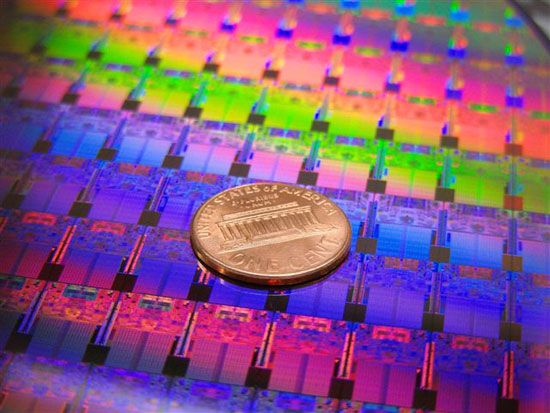Intel Core 2 Extreme QX9650 - Penryn Ticks Ahead
by Anand Lal Shimpi on October 29, 2007 12:13 AM EST- Posted in
- CPUs
Final Words
It's almost a bit disheartening to see Penryn launch at only 3.0GHz, as we know the architecture is capable of so much more. Unfortunately, what it looks like we're seeing here today is an artificial slowing of Intel's roadmap in response to the competition. While the tick-tock model is still very much in play and Nehalem is on track for a late '08 release, we're getting a 1333MHz FSB 3.0GHz QX9650 today instead of a 1600MHz FSB 3.2GHz Q9770 because there's no competitive reason for anything more. AMD's Phenom still isn't out and all indications are that we won't see 3GHz from AMD until sometime next year, meaning that Intel definitely doesn't have any real incentive to push the performance envelope this year.
Penryn really offers a wide range of performance; at worst it's no faster than its predecessor, but at best we're looking at low double digit performance gains. The biggest improvements seem to come in the encoding, 3D rendering and image manipulation applications, which makes sense when you look at the nature of the architectural improvements in Penryn.
The tremendous reduction in power consumption is very exciting and arguably one of the more desirable features of Penryn. The initial SSE4 results do look promising, but as we've often seen with new instructions, it's anyone's guess as to when we'll see widespread adoption of them from developers (and how much they will truly help in everyday use). The fact that we're able to bring you real world DivX performance results today though is promising.
Given that we're expecting a seamless price transition, it's tough to really find fault with Penryn. While the performance bumps can vary from minor to major, the cost should be nothing to the end user, in which case we can't complain. It's not the revolutionary step that Conroe was, but Penryn is merely making everything a little better all while driving power consumption down. So long as Intel keeps its prices the same, we're happy.

So what are the final words on it? As an evolution of Conroe, Penryn gets our vote. We just want it at lower price points, please.










16 Comments
View All Comments
emenk - Sunday, January 20, 2008 - link
From first page (this article): "As we saw in our original Penryn preview, Penryn's cache performance remains unchanged; latencies in our final stepping are identical to Conroe."From the original Penryn preview (3rd page):
"Not only is Wolfdale's L2 cache larger, but it also happens to be slightly faster than its predecessor. Intel has shaved off a single clock cycle from Wolfdale's L2 access time; we're already off to a good start."
Isn't this a contradiction?
Ignore this (testing quote tags):
[quote]Quote goes here.[/quote]
IntelUser2000 - Tuesday, October 30, 2007 - link
You know that will not be true in the true Phenom comparison right Anand?? Take a look here: http://techreport.com/articles.x/8236/14">http://techreport.com/articles.x/8236/14Dual Opteron is slower than a Single Opteron, yet you still used Dual Opteron against a single Barcelona. Why?? No really, WHY?!?
"Because of these limitations we refrained from running any comparative benchmarks to desktop Athlon 64 X2s, instead we chose to run a single quad-core Opteron in our server platform against a pair of dual-core Opterons to simulate Phenom vs. K8 on the desktop."
You could have took games like Oblivion with Single socket Opteron to see the real advantages. This is the worst comparison, ever. And to make it worse, you put "simulated" benchmarks.
victory - Tuesday, October 30, 2007 - link
Wouldn't Intel be able to take immediate advantage of the new SSE4instructions in a new integrated graphics chipset perhaps then
competing with nVidia as well as beating AMD's integrated chipsets?
magreen - Monday, October 29, 2007 - link
It does 4GHz easily on the stock cooler? So why don't you strap a TR ultra 120 ex on there and tell us what it can really do? Cmon Anand, stop teasing us and tell us what we really want to know!AnnihilatorX - Monday, October 29, 2007 - link
It's a shame that they delay the release date of more affordable Yorkfields to January, just missed to Christmas sales.I am p0lanning to upgrade my computer and not sure whether to wait for Yorkfield or buy a Q6600.
idgaf13 - Monday, October 29, 2007 - link
Intel is trying to suppress Christmas sales and have a negative influence on "other companies" earnings while relieving themselves of Old Inventory.45nm process is going to produce so many CPUs per wafer that prices will fall fast or inventory will rise quickly.
With respect to the traditional cycle of product releases and price changes ,
A January launch date allows for the longest possible time before prices begin to tumble
typically after the trade shows in the first two quarters of the year.
It also more time to perfect the production process.
Question is do really need to be "the first on the block" to have this CPU ?
Or can you wait until the price falls by 50% or June/July for the best price?
Possibly even a faster CPU by then.
MGSsancho - Monday, October 29, 2007 - link
anand, could you be so kind as to point to where you got the info on the new sse4 instructions? the chart would be cool but some pdfs or something from into would be awsomejsaldate - Friday, November 9, 2007 - link
Penryn SDK: http://softwarecommunity.intel.com/articles/eng/11...">http://softwarecommunity.intel.com/articles/eng/11...http://softwarecommunity.intel.com/articles/eng/11...Ryan Smith - Monday, October 29, 2007 - link
http://www.intel.com/technology/architecture-silic...">From Intel's websiteMGSsancho - Monday, October 29, 2007 - link
thanks a lot =)